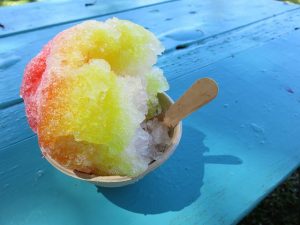Welcome to my article about the differences between snow cones vs shaved ice.
Frozen desserts are always a welcome treat whatever the season. This is the reason you’ll find snow cones or shaved ice in almost all corners of the world. But did you know that these two types of ice are different?
Read on to learn the pros and cons of each type of ice, what each are typically used for, and when you want to choose one over the other. But first, a brief description of snow cones vs shaved ice for those who are in a hurry.
Contents
The Difference Between Snow Cones and Shaved Ice Is:
The difference between snow cones vs shaved ice comes down to the texture of the ice. Snow cones are grainier with larger particles of ice, while shaved ice is finer, lighter and more akin to snow.
Snow cones are also typically less expensive as shaved ice.
They both can come with toppings and fruits, but shaved ice absorbs the flavors of these toppings better than snow cones.
However, no matter what the differences, both snow cones and shaved ice are delicious! Now let’s get into the details of both types of ice.
What is a Snow Cone?

Also known as: Snowballs, Sno Cones, Snow Kones
Texture: Granular and crunchy
Snow cones are treats made from ice that come in large granules. They come with a drizzle of sweet flavourings that almost always settle on the bottom of the cup, making the last few bites the most delightful.
They are crunchy, come in a wide array of flavours, and are usually served in a cone-shaped cup, hence the name snow cones.
What is Shaved Ice?

Also known as: Hawaiian shaved ice, shaver
Texture: Light and airy
On the other hand, shaved ice comes with fine, fluffy, and lightweight ice. Because of this, the syrup stays on the ice throughout, making the last bite as delicious as the first.
They typically come in a larger selection of flavours than snow cones. Most of the time, shaved ice comes with fruits, toppings, and many other variants.
What Do I Need to Make a Snow Cone?
To make wonderful snow cones, you’ll need a trusty snow cone machine, blocks or cubes of ice, plastic, paper, or foam cups, and your syrup or flavourings.
What Do I Need to Make Shaved Ice?
A shaved ice machine is what you’ll need to craft these fantastic creations. You’ll also need waxed or paper cups, syrup, and toppings.
Brief History of Snow Cones
A hundred or so years ago, snow cones were invented and have stayed in our minds ever since.
As early as the 19th century, kids in Baltimore, Maryland, would follow the ice wagons that delivered blocks of ice to businesses that needed refrigeration.
They would ask for the shavings and parents added the flavours to them. This was when snow cones’ popularity grew along with the egg custard flavour that became then synonymous with these ice delights.
Brief History of Shaved Ice
The first shaved ice was enjoyed by Japanese immigrants working on the plantations in Hawaii in 1869. They used tools to shave ice from blocks to cool off the tropical heat.
They added sugar to sweeten them and then evolved to include fruits and fruit juices. Some records claim that shaved ice was first created by the Japanese living in the port town of Yokohama, also in 1869.
Whoever was the first to create shaved ice, everyone deserves the credit for a frozen treat enjoyed the world over.
Popular Ice Treats From Around the World
Almost every country in the world has its version of snow cones or shaved ice. This is proof that everyone loves desserts made with ice. Below are some of the most famous ice desserts from different countries all over the world:
Chinese Bao Bing
China also has its version of the shaved ice, the Bao Bin has been around for hundreds of years and has spread its popularity around Southeast Asia and the world. The original version of Bao Bing is a bowl of shaved ice topped with red beans and condensed milk.
Today, the Bao Bing is served with a wide selection of toppings such as lychee, mango, strawberry, grass jelly, even taro, among many others.
Mexican Raspado
The Mexican ice treat got its name from the word raspado which means “scrape” in Spanish. Mangos and papayas are common raspado toppings but you’ll also find tamarind and eggnog as favourites. It became famous in other American Southwest nations that chamoy sauce, dill pickles, and chilli salt have become raspado topping staples.
Hawaiian Shaved ice
A possible descendant of the Kakigori, the two have many similarities, all wonderfully good and refreshing. Locally-found fruits have become the stars of this frozen treat, some of which are kiwis, pineapples, guavas, mangos, and lychees.
One important feature of the Hawaiian shaved ice is the scoop of ice cream that you’ll find at the bottom of the ice, which serves as a delightful surprise to end the dessert.
Thai Nam Kang Sai
A cool dessert that you can find anywhere in the country is Thailand’s Nam Kang Sai. It is made with ice that’s shaved to resemble sorbet. It is filled to the brim with toppings and drizzled with coconut milk or a syrup called sala syrup.
Toppings may include sweet corn, taro, jackfruit, water chestnut, and even bread cubes. They are served anywhere from streets to malls, and fancy restaurants.
Taiwanese Xue Hua Bing
What makes Taiwan’s ice treat different is that it uses frozen sweetened milk rather than plain ice. This makes it extra flavorful and unique. To make it even better, the frozen milk is enhanced with flavourings such as green tea and mango.
Toppings can include mochi, grass jelly, red bean paste, and many others.
Japanese Kakigori
The Kakigori was once served exclusively to aristocrats in the 10th century. It was only when ice became more accessible did it reach the public palate back in the 1800s. Thin ice shavings are placed in a bowl and pressed.
They are then blended with different syrups, typically with matcha, strawberries, melons, lemons cherries, and many other fruits. Kakigoris are usually topped with evaporated or condensed milk.
Filipino Halo-Halo
Of all the desserts that you can get in the Philippines, the Halo-Halo is probably the most popular. Halo-Halo is the Tagalog word for mix-mix, meaning a crazy mixture of fruits, root crops, and other assortments of toppings. These are served with evaporated milk, caramel flan, red beans, bananas, coconut gels, and many other native ingredients.
Halo-Halo is typically served in a tall glass with the ingredients on the bottom, the shaved ice over them, and a scoop of ice cream as a topping. You then stir in all the ingredients to mix them all, thus the name Halo-Halo.
Snow Cones vs Shaved Ice – Conclusion
I hope this article has helped clarify the difference between snow cone and shaved ice. Now you should be able to pick your icy dessert treat and know exactly what you’re getting!
Here are some related articles you may also enjoy:
Different Types of Ice
Best Ice Maker Refrigerators

Hi there, I’m Richard Parker! I own two food truck businesses in Hawaii, selling snow cones, gelatos and frozen drinks. I’ve been working with ice makers for most of my professional career, and created this website to pass on my knowledge. I hope you enjoy!
Leave a Reply